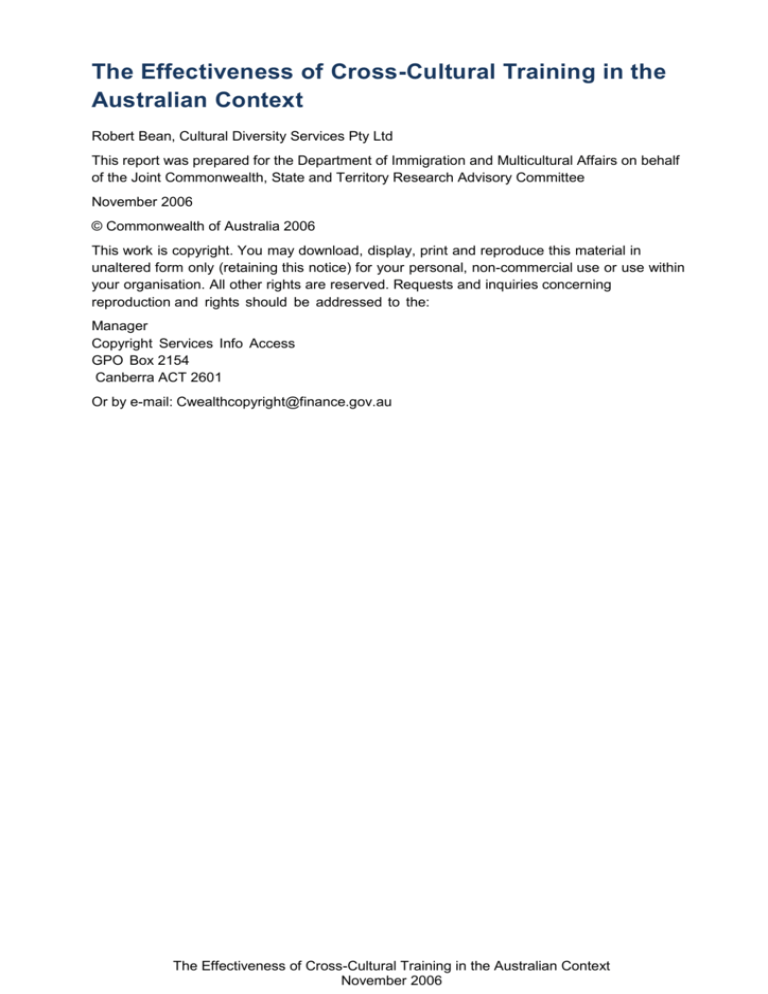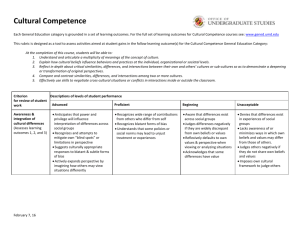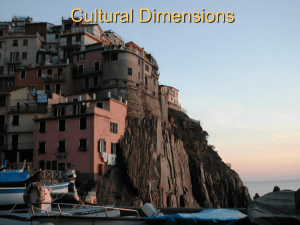
The Effectiveness of Cross-Cultural Training in the
Australian Context
Robert Bean, Cultural Diversity Services Pty Ltd
This report was prepared for the Department of Immigration and Multicultural Affairs on behalf
of the Joint Commonwealth, State and Territory Research Advisory Committee
November 2006
© Commonwealth of Australia 2006
This work is copyright. You may download, display, print and reproduce this material in
unaltered form only (retaining this notice) for your personal, non-commercial use or use within
your organisation. All other rights are reserved. Requests and inquiries concerning
reproduction and rights should be addressed to the:
Manager
Copyright Services Info Access
GPO Box 2154
Canberra ACT 2601
Or by e-mail: Cwealthcopyright@finance.gov.au
The Effectiveness of Cross-Cultural Training in the Australian Context
November 2006
Table of Contents
Executive Summary
Recommendations
Action Guide for Implementing Cross-Cultural Training Programs
Chapter 1 Study Objectives and Background
1.1 Objectives of the Study
1.2 Cross-Cultural Training Issues in Australia
1.3 Challenges in Evaluating Cross-Cultural Training Effectiveness
Chapter 2 Methodology
2.1 Project Design
2.2 Stage 1 Methodology
2.2.1 Literature Review and Stakeholder Consultations
2.2.2 Survey Design, Sample Selection and Responses
2.3 Stage 2 Methodology
2.3.1 Phase 1 Surveys: Pre-Training Survey and Immediate Post
Training Evaluation Sample Selection and Responses
2.3.2 Phase 2. Longitudinal Evaluation Survey
2.4 Comparative Analysis of Phase 1 and 2 Responses
2.5 Survey Rating Scale
2.6 Comparison with International Studies
Chapter 3 Literature Review: Cultural Competence and the Role of
Cross Cultural Training
3.1 Culture and Cultural Competence
3.1.1 Systemic and Organisational Cultural competence
3.1.2 Individual and Professional Cultural competence
3.2 Cross-Cultural Training
3.2.1 Definitions of Cross-Cultural Training
3.2.2 Historical Development of Cross-Cultural
3.2.3 The Types and Objectives of CCT
3.2.4 Cross-Cultural Training Content and Processes
3.2.5 Approaches and Delivery Methods
3.3 Cross-Cultural Training Effectiveness
3.3.1 Cross-cultural trainer competence
The Effectiveness of Cross-Cultural Training in the Australian Context
November 2006
3.3.2 Training Program Design
3.3.3 Cross Cultural Training Tools and Resources
3.4.4 Measuring the Effectiveness of Cross-Cultural Training
Chapter 4 Cross-Cultural Training Practice in the Australian Public
Sector 2000 2005
4.1 Industry Consultations
4.2 Cross-Cultural Training Activity 2000-2005
4.3 Organisational Support for Cross-Cultural Training
4.4 Management Assessment of Cross-Cultural Training Programs
4.5 Characteristics of Cross-Cultural Training Providers
4.6 Perceived Future Demand for Cross-Cultural Training
4.7 Implications of Consultations and Survey Findings
4.7.1 Policy Implications
4.7.2 Planning and Provision Implications
4.7.3 Performance Implications
Chapter 5 Australian Cross-Cultural Training Providers and Trainers
5.1 Profile of Training Provider Organisations
5.2 Cross Cultural Training Delivery Modes
5.3 Profile of Cross-Cultural Trainers
5.4 Training Methodology and Resources
5.5 Professional Development
5.6 Challenges Facing the Cross-Cultural Training Field
5.6.1 Socio-Political Issues
5.6.2 Credibility Issues
5.7 Recommendations for Industry Development
5.7.1 Research
5.7.2 Resources
5.7.3 Professional
5.7.4 Accreditation of Trainers
.7.4 Registration of Trainers
5.8 Conclusions
The Effectiveness of Cross-Cultural Training in the Australian Context
November 2006
Chapter 6 Evaluation of Cross-Cultural Training in the Australian
Public Sector 2005-2006
6.1 Summary of Evaluation Survey Findings
6.2 Research Conclusions
6.2.1 Perceived Effectiveness of CCT
6.2.2 Results and Benefits of CCT
6.2.3 Organisational Factors
6.2.4 Training Program Recommendations
6.3 Pre-Training Survey Findings 2005
6.3.2 Pre-Training Self Assessments
6.4 Immediate Post-Training Survey Findings 2005
6.4.1 Effectiveness of Programs and Trainers
6.4.2 Recommendations for Improvement of Training
6.5 Comparisons of Pre-Training and Immediate Post-Training Surveys
6.5.1 Statistical Comparisons of Pre-Survey and Training Evaluation
Survey
6.5.2 Workplace applications and benefits
6.5.3 Benefits to the Organisation
6.6 Longitudinal Cross-Cultural Training Evaluation Survey 2006
6.6.1 Profile of Training Programs Evaluated
6.6.2 Duration of Training Programs
6.6.3 Effectiveness of Programs and Trainers
6.6.4 Recommendations for Improvement of Training Programs
6.7 Comparisons of Pre-Training, Immediate Post-Training Evaluation and Longitudinal
Post-Training Evaluation Survey
Findings
6.7.1 Statistical Comparisons
6.7.2 Understanding of Organisational Policies and Issues
Regarding Cultural Diversity
6.7.3 Understanding of Influences of Own Culture on Self
6.7.4 Knowledge of Cross-Cultural Communication Skills
6.7.5 Knowledge of Other Cultures
6.7.6 Confidence in Dealing with Different Cultures
6.7.7 Perceived effect of cultural diversity on interactions
The Effectiveness of Cross-Cultural Training in the Australian Context
November 2006
6.7.8 Importance of cultural competence for work
6.8 Comparisons of Pre-Training, Immediate Post-Training
Evaluation and Longitudinal Post-Training Evaluation Survey Findings on Workplace
Applications
6.8.1 Interest in and Actual Extent of Applying Training to the Workplace
6.8.2 Confidence in and Experience of Transferring Knowledge
6.8.3 Contribution of Training to Job Effectiveness
6.8.4 Anticipated and Actual Benefit to the Organisation
6.8.5 Demand for Further Training
6.8.6 Influence of Cross-Cultural Training on Views and Responses to Cultural
Diversity
6.9 Comparisons of Immediate Post-Training Evaluation and Longitudinal Post-Training
Evaluation Survey Organisational
Observations and Recommendations
6.9.2 Importance of Cultural competence for Working with Culturally Diverse CoWorkers
6.9.3 Frontline Manager Support for CCT
6.9.4 Senior Management Support for CCT
6.9.5 Staff Support for CCT
6.9.6 Cultural competence in Performance Appraisal
6.9.7 Recommendations for Future Cross-Cultural Training
6.9.8 Accreditation of CCT Programs
6.9.9 Other Comments
Chapter 7 General Guidelines for Implementing Cross-Cultural
Training Programs
7.1 Training Program Initiation
7.1.1 The Organisational Contexts of CCT
7.1.2 The Legal Context
7.1.3 The Strategic Context
7.1.4 The People Management Context
7.2 Training Needs Analysis and Program Development
7.2.1 Cultural competence Assessment
7.2.2 Training Needs Analysis Processes
7.2.3 Training Program Objectives
7.2.3 Types of Training Programs
The Effectiveness of Cross-Cultural Training in the Australian Context
November 2006
7.2.4 Training Programs Arrangements and Configurations
7.2.5 Training Approach and Style
7.2.6 Training Content and Resources
7.2.7 Locating and Selecting CCT Trainers
7.2.8 Working with Cross-Cultural Trainers
7.3 Training Program Delivery
7.3.1 Establishing Program Legitimacy
7.3.2 Promoting CCT Programs
7.3.3 Preparing for CCT Programs
7.3.4 Conducting CCT Programs
7.4 Training Program Evaluation and Follow-up
7.4.1 Evaluation Strategies and Techniques
7.4.2 Program Follow-Up
References
Appendices
Appendix A
Detailed Results: 4. Survey of Current Cross-Cultural Training Practice in the Australian
Public Sector 2000-2005
Detailed Results
5. Survey of Cross Cultural Training Providers and Trainers
Part A: Cross Cultural Training Providers
Part B: Survey of Cross-Cultural Trainers
Appendix B
Detailed Results: Evaluation of Cross-Cultural Training in the Australian Public Sector 20052006
Appendix C. List of Participating Organisations
Appendix D: Tests for Statistical Significance
Appendix E: Sample Questionnaires
The Effectiveness of Cross-Cultural Training in the Australian Context
November 2006
Acknowledgements
The Effectiveness of Cross Cultural Training in the Australian Context project, which
commenced in June 2005, was commissioned by the Commonwealth Department of
Immigration and Multicultural Affairs (DIMA) on behalf of the Joint Commonwealth, State and
Territory Research Advisory Committee.
Project Team
Project Manager and Principal Researcher
Robert Bean, Managing Director, Cultural Diversity Services Pty Ltd
Research Team
Nick Stone, Director, Lifelong Learning Services
Caroline Pinto, Director, ICDR (Australia) Pty Ltd
Dr Melissa Butcher, Researcher, Research Institute for Asia Pacific, University of Sydney
Dr Pat Mehegan, Consultant
Judith Miralles, Director, Judith Miralles and Associates
Geoff Pearson, Director, Agenda Communications Pty Ltd
Tom Verghese, Director, Cultural Synergies Pty Ltd
Tamerlaine Beasley, Director, Beasley Intercultural
Statistician
Dr Carl Johan Rohlin, Director, Bramble Bay Demographic & Economic Consulting
Project Working Group
Abbas Adam, Director, Productive Diversity Section, DIMA
Margot Reedy, Project Manager, Research & Statistics Section, DIMA
Warren McMillan, Manager, Multicultural Affairs Queensland
Sylvia Brdjanovic, Senior Policy Advisor, Multicultural Affairs Queensland
Kelly Yip, Senior Policy Officer, Multicultural Affairs Queensland
Dr Stephen Brock, Policy and Project Officer, Multicultural South Australia
Dr Ban-Lian Ng, Senior Policy Officer, Victoria Office of Multicultural Affairs
Nicholas Chiam, Senior Policy Advisor, Victoria Office of Multicultural Affairs
This study would not have been possible without the generous support and cooperation of the
hundreds of people who provided comments and information and completed surveys.
Special thanks goes to the training providers and their client organisations, listed on page 17,
for their assistance in promoting and administering the longitudinal training evaluation
surveys and to the 515 training participants who agreed to be involved.
The views expressed in this report are those of the author and do not necessarily represent
those of the Department of Immigration and Multicultural Affairs or those of the State and
Territory Governments.
The Effectiveness of Cross-Cultural Training in the Australian Context
November 2006
Executive Summary
A 15-month national research study of the effectiveness of cross-cultural training (CCT)
in the Australian public and community sectors has produced statistically significant evidence
that CCT is of direct benefit to employees, their organisations and their clients. The study,
which involved a review of the literature, consultations with 195 stakeholders and five surveys
involving 718 managers, trainers and participants, has also identified policy, planning and
performance issues regarding the future provision of CCT.
Project Objectives
•
•
•
To identify and document the nature, extent, status, best practice approaches and
effectiveness of cross-cultural training as a strategy for achieving multicultural policy
objectives.
To establish credible data to guide the future policy development and current
management decisions of agencies responsible for multicultural affairs, government
agencies and community organisations working to implement the Charter of Public
Service in a Culturally Diverse Society, and cross-cultural trainers, in relation to the
justification of the utilisation of resources for cross- cultural training.
To provide guidelines on the implementation of effective cross-cultural training
and the development needs of the cross-cultural training field.
Key Findings
•
•
•
•
•
•
•
•
Cross-Cultural Training (CCT) is an important element in the development of
individual and organisational cultural competence, which underpins the social
cohesion and social capital of Australian society.
A survey of public sector current practice over the period 2000-2005 produced
consistent qualitative evidence that CCT programs were effective in achieving their
objectives, although the level of training activity was low compared to estimated
levels of demand and recommendations for increased training.
The majority of public sector and community organisations surveyed expected
increased or greatly increased demand for CCT over the next five years, with
improving customer service the main driver for this demand.
Comparisons of pre-training, immediate post training and longitudinal training
evaluation surveys involving 515 public sector employees showed statistically
significant improvements in their awareness of cultural influences on customer and
workplace interactions, knowledge and understanding of other cultures and
understanding of organisational cultural diversity policies and issues.
Due to the brevity of the 39 CCT programs evaluated (averaging six hours) and the
general absence of organisational measurements of cultural competence, the
training did not result in gains in other areas such as understanding the deeper
effects of one’s own culture on oneself and in confidence to transfer cross cultural
skills to the workplace and to colleagues.
Over 60% of participants would like more cross-cultural training, indicating their
acknowledgement that the development of cultural competence is a complex and
on-going learning process.
CCT training was rated highly by the great majority of participants, 88%
recommending that it be compulsory for all staff in customer contact positions.
The demonstrated fact that even short training programs result in benefits and
stimulate interest in further learning indicates that investments in more robust and
job-focused CCT will be likely to deliver greater measurable returns for
The Effectiveness of Cross-Cultural Training in the Australian Context
November 2006
•
•
•
organisations.
Although the majority of managers surveyed and recognized the importance of
cultural competence to service quality and workforce relations, few organisations
conducted CCT programs on a regular basis or included cultural competence in
performance appraisals.
The future development of cultural competence at all levels of organisations and
systems will require its inclusion in formal competency standards and organisational
development strategies.
Cross-cultural trainers identified needs for professional development, for further
research and for the development of Australian training resources.
The Australian Context of Cross-Cultural Training
Cross-cultural training must be evaluated in the broader context of Australian social and
economic trends and needs in relation to social cohesion, governance, immigration, workforce
development, globalisation and economic competitiveness.
Social cohesion and the development of human capital rely to a large degree on a society’s
social capital, described as the networks and norms of reciprocity and trust that enhance
productivity (McGaw, 2006). Underpinning social capital and social cohesion is cultural
competence, which can be broadly described as the ability of systems, organisations,
professions and individuals to work effectively in culturally diverse environments and
situations. Cross-cultural training, which aims to develop the awareness, knowledge and skills
needed to interact appropriately and effectively with culturally diverse customers and coworkers, is an important element in the development of cultural competence.
Cultural competence is critical to the achievement of national multicultural policy objectives
and to the success of the immigration and settlement process. As Australia comes to rely
increasingly on its ability to attract and retain skilled migrants from diverse cultural
backgrounds, the ability to demonstrate social cohesion and inclusion will enhance the nation’s
competitiveness with other nations experiencing skills shortages. Cultural competence is vital
to international trade performance and the fulfilment of international diplomacy and security
responsibilities. The recognition and leveraging of workforce cultural diversity can also
constitute a sustainable competitive advantage for enterprises in every industry. Awareness of
these drivers is evident in the organisations involved in this study.
Consultations with and information received from 195 representatives of public and community
sector organisations and CCT training providers across Australia identified a growing need for
cultural competence, driven mainly by customer expectations and policy and compliance
requirements. However, while respondents reported that there was ample anecdotal
evidence of the benefits of CCT to individuals and organisations, wider use of CCT was
hindered by a perceived lack of consistency in CCT approaches and aims and the absence of
clear measures of cultural competence and practical guidelines for implementing programs.
The position of CCT in training and development frameworks and strategies is not clear and
cultural competence is not yet recognised as a generic skill in most industries.
Two on-line surveys of current practice and training providers received 203 responses, a
response rate of 34% of the 595 Commonwealth, state, local government, community and
training provider organisations that were invited to participate. The data from these
surveys, summarised below and discussed in Chapters 4 and 5, are presented in full in
Appendices A and B.
The Effectiveness of Cross-Cultural Training in the Australian Context
November 2006
Survey of Current Cross-Cultural Training Practice in the Australian Public Sector
Responses to the current practice survey were received from 105 representatives from 93
government and community organisations. The findings of this survey revealed a generally
modest level of C C T activity. The 93 responding organisations conducted an average of five
training events per year averaging 5.2 hours duration, mainly for staff level employees. The
types of training conducted were general cultural awareness, programs on specific cultures,
working with interpreters, specialised programs for fields such as health and policing, and
managing culturally diverse workforces. The main training objectives were to improve
customer service, workplace communication, community relations, compliance with laws and
policies, marketing of services and international business skills.
Over 83% of survey respondents rated CCT effective to extremely effective in meeting these
objectives, based on participant feedback, workplace assessment and feedback from external
stakeholders. Participant satisfaction with CCT programs was rated as high or very high by 63%
of respondents.
The degree of importance that managers placed on cultural competence in dealing with
culturally diverse customers and co-workers was rated at 3.65 on a 5-point scale and the
degree of management support for CCT was rated at 3.59. However, while 87.6% of
respondents stated that employee cultural competence was important or very important to
managers, only 55.6% rated management support for CCT as strong or very strong. CCT was
mainly offered on a voluntary basis and only 13.8% of respondents reported that cultural
competence was always or usually included in performance appraisals.
Commenting on the future of CCT in their organisations, 73.9% of respondents expected
increased or greatly increased demand for general CCT over the next five years, driven mainly
by increasing customer service requirements and expectations and workforce factors including
staff demand for training, labour market forces and diversity initiatives. The majority
predicted initiatives to develop and implement
policies for culturally inclusive work practices and to include cultural competence in other
training programs.
Survey of Cross-Cultural Training Providers and Trainers
There were 98 responses to this survey, representing 76 organisations and individual CCT
trainers. Their main areas of training expertise were in general cultural awareness, specialised
CCT and diversity management. Two thirds of their training provision was to government and
community organisations and one third to the private sector.
The training providers’ responses concerning current practice in their client organisations,
including types and aims of training and the levels of management support for CCT were
very similar to the organisational responses summarised above.
The main challenges facing training providers were in dealing with socio-political issues
surrounding diversity, demonstrating the value of CCT to stakeholders and resolving training
methodology issues. Ensuring the future development of the CCT field presented further
challenges, including the development of accreditation standards, establishment of
professional development programs and the production of training resources tailored to the
Australian multicultural context.
The profile of CCT trainers showed that 90% were Australian citizens, 77% were female and
68% spoke two languages. Their average age was 48, a significant factor in terms of the
experiential background of trainers and the capacity of the field to meet increased future
The Effectiveness of Cross-Cultural Training in the Australian Context
November 2006
demand. CCT was not the sole activity of most trainers, who conducted an average of 20
workshops a year. Many were also involved in research, development and other forms of
education and training. Their responses to questions regarding their motivation displayed a
high level of passion, commitment and engagement, reflecting the common observation in the
literature that enthusiastic and committed facilitators are essential to effective CCT.
While 76% have had specific training in their areas of expertise, many professional
development needs were identified including training in the psychology of cross-cultural
effectiveness and about specific cultures and the development of training resources for the
Australian context. Topics for further research included cultural competence in teams and
leadership, cultural diversity in the contexts of power and policy and models for understanding
culture and identity in the Australian social and economic contexts.
Surveys of the Effectiveness of Cross-Cultural Training
The objective of cross-cultural training is to develop awareness of the cultural dimensions of
interactions and effectiveness in situations and environments characterised by cultural
diversity. To evaluate the effectiveness of CCT programs over time in Australian public sector
organisations, a pre-training survey, an immediate post-training survey and a longitudinal
training evaluation survey were conducted over an 11-month period from July 2005 to June
2006. The first two surveys were completed by 515 training participants in 39 groups from 31
government and community organisations. Of these, 145 participants responded to the
longitudinal survey, giving a 28% response rate.
The participants attended five types of CCT programs, focused on general cultural
awareness (51%), specialised training (22%), working with cultural diversity (16.2%), working
with interpreters (7.4%) and train-the-trainer (3.5%). The average duration of programs was
6.1 hours, with 92% conducted over periods of one day to one hour.
The immediate post-training evaluation ratings in 2005 showed increases on all of the areas of
knowledge and awareness against which participants self-rated themselves in the pre-survey.
The highest percentage point increases were in the areas of understanding of organisational
policies and issues (21%), knowledge of cross-cultural skills (26%) and understanding of other
cultures (25%). There were smaller improvements in understanding of the effects of one’s own
culture on oneself, awareness of the effects of cultural differences on interactions and
confidence in dealing with people from different cultures. Ratings of program design, trainer
effectiveness, trainer knowledge, interactivity and overall satisfaction were all above 4 on a 5point scale.
The contribution of the training program to participants’ job effectiveness received an average
rating of 3.8 on a 5-point scale. Participants reported potential benefits to their organisation
through increased knowledge of and improved service to culturally diverse customers and
transfer of their learning to co- workers. Participants’ level of interest in applying learning to
work was rated at 4.5. Seven out of ten participants rated their confidence in their ability to
transfer learning to colleagues as above average or higher.
Comparisons of the responses to 2005 pre-training and the 2006 longitudinal questions
showed statistically significant (95% confidence level) increased percentage changes in three
areas:
•
•
•
•
understanding of organisational policies and issues regarding cultural diversity
(12.3% increase on 2005 ratings)
knowledge of cross-cultural communication skills
(17.1% increase on 2005 ratings)
The Effectiveness of Cross-Cultural Training in the Australian Context
November 2006
•
•
knowledge and understanding of the customs, values and beliefs of diverse cultures
(16.7% increase on 2005 ratings)
There were smaller, statistically insignificant, increases in awareness of the influence of one’s
own culture on oneself and the degree to which cultural differences affected interactions. The
lack of significant gains in these deeper areas of cultural competence can be seen as further
indication of the limits of short, introductory CCT programs.
Participants’ perceived importance of cultural competence to their work performance and their
confidence to work with different cultures showed no significant change from the previous
surveys.
The average decrease of 20.2 percentage points between participants’ relatively high
immediate post- training expectations of the training’s contribution to performance and their
actual experiences of transferring their learning to the workplace points to the need for
organisations to ensure the application of learning to performance.
CCT positively affected participants’ views of cultural diversity and stimulated interest, with
61% indicating they would like further training and 41% recommending longer programs.
Reported benefits to the organisation included improved customer service and greater
awareness of customer needs and increased use of support services. Reflecting the perceived
value and relevance of the training, 87.7% of participants recommended that CCT be
compulsory for all staff in customer service positions.
The training evaluation survey results demonstrate the benefits of CCT. However, the basic
level and short duration of the majority of the CCT programs evaluated limited the effectiveness
of the training in developing the skills required to achieve individual cultural competence and
apply it to the workplace. The effectiveness of CCT in contributing to organisational cultural
competence may also be limited by the ability of organisations to adopt new perspectives on
cultural diversity and an absence of competency standards and performance indicators that
factor recognition of cultural diversity into processes and procedures.
Conclusions
The effectiveness of cross-cultural training in contributing to the cultural competence of the
Australian public sector context depends on a number of related elements.
At the systemic and organisational levels, cultural competence must be closely linked to policy
requirements and organisational values and service delivery objectives and expressed in high
levels of political, leadership and managerial support for CCT.
At the professional level, cultural competence must be integrated into the standards and
competency and performance frameworks of professions and occupations.
At the individual level, CCT is most effective when it addresses the concerns and motivations
of participants and is provided within an organisational context that provides opportunities and
incentives for applying acquired cross-cultural knowledge and skills to the workplace.
To effectively facilitate the development of cultural competence, cross-cultural trainers need
support in the areas of professional and resource development.
Cross-cultural training is an effective strategy in the achievement of organisational
performance targets and multicultural policy objectives. Addressing the identified limitations of
current practice in CCT will increase its contribution to the development and enhancement of
organisational and individual cultural competence.
The Effectiveness of Cross-Cultural Training in the Australian Context
November 2006
Recommendations
Recommendation 1: Develop Cultural Competence Management Frameworks,
Guidelines and Resources
Commonwealth, state and local governments should develop and promote planning
frameworks, implementation guidelines and supporting management training resources. This
will enable systems and organisations to incorporate cross-cultural training into organisational
development, compliance and market relations strategies, specifying relevant aspects of
professional and organisational cultural competency to be included in reporting requirements
as an integral part of performance appraisal of agency heads and senior executives.
Recommendation 2: Develop a Cultural Competence Assessment Framework
Commonwealth, state and local governments and community service organisations should
develop frameworks identifying the criteria for assessing the cultural competence
requirements of job specifications at all levels for use in recruitment, professional
development, performance appraisal and career development.
Recommendation 3: Promote Training Programs and Resources for Managing
Cultural Diversity and Cross-Cultural Communication
Commonwealth, state and local governments, education institutions and community service
organisations should more widely promote their existing cultural competence training programs
and resources to encourage and assist other public and community sector organisations to
assess and further develop their cultural competence.
Recommendation 4: Provide Cross-Cultural Training Advice and Support
All levels of government, and multicultural agencies in particular, should establish and promote
points of contact to provide information and advice on cross-cultural training to all interested
organisations, to promote best practice and to encourage and support the development of
cultural competence in the workforce.
Recommendation 5: Develop Registers of Cross-Cultural Training Providers
The appropriate agencies at all levels of government should develop nationally-consistent
registers or panels of qualified cross-cultural training providers which are accessible to all
levels of government and the private sector and which include links to registers in other
jurisdictions. The design of the registers should be based on existing training and consulting
procurement processes and be informed by work being done in South Australia and
Queensland regarding providers of cross-cultural training.
Recommendation 6: Establish a National Cross-Cultural Trainers Professional
Association
Australian cross-cultural trainers should establish a national association of practitioners in
cross-cultural training, consulting, research and development, either as a separate entity or
within or in affiliation with existing national and/or international professional bodies.
Recommendation 7: Support the Professional Development of Cross-Cultural
Trainers
Relevant commonwealth and state education authorities should work with the cross-cultural
training field to investigate the possibility of establishing professional development pathways
and programs for cross-cultural trainers, including formal tertiary qualifications and continuing
professional education, to meet the needs of existing trainers and to attract and develop new
The Effectiveness of Cross-Cultural Training in the Australian Context
November 2006
trainers to the field.
Recommendation 8: Conduct Further Cultural Competence Research
All jurisdictions should identify and commission further research into relevant aspects of
cultural competence development including:
•
•
•
•
the overall scope and effectiveness of CCT within the jurisdiction
the relative effectiveness of different CCT training types, approaches and
configurations in contributing to improved cultural competence in job performance in
specific sectors industries and professions
the degree to which occupational or industry systems and practices impede or
foster the development and application of cultural competence in the workplace, and
the extent to which cultural competence learning is integrated into learning pathways
in the schools, VET and higher education sectors and applicable to employment and
career development.
Action Guide for Implementing Cross-Cultural Training Programs
The following steps, based on the research findings and content of this report, outline the
process of planning, developing and conducting a cross-cultural training program.
Step 1:
Define the Organisational Context and Training Objectives
Establish the relationship of cultural competence to the organisational, legal and people
management contexts. Define the training needs and objectives.
Ensure strong organisational support for the training program.
See Chapter 4: Survey of Cross-Cultural Training Practice in the Australian Public Sector
See Chapter 7: Guidelines for Implementing Cross-Cultural Training Programs
Step 2:
Understand Cultural Competence and Cross-Cultural Training
Before embarking on a CCT program, be clear on the nature of cultural competence, the
range of
CCT approaches and the criteria for an effective CCT trainer.
See Chapter 3: Cultural Competence and the Role of Cross-Cultural Training
Step 3:
Promote the Value of Cross-Cultural Training to the Organisation
Demonstrate the value of CCT to all stakeholders with the statistical evidence and qualitative
comments from this research study.
See Chapter 6: Evaluation of CCT in the Australian Public Sector
Step 4:
Design and Conduct Cross-Cultural Training Effectively
Study the range of options for CCT and resources that will ensure the training objectives are
met. Select the appropriate trainers and work closely with them. Organise and conduct the
program for maximum effectiveness.
See Chapter 7: Guidelines for Implementing Cross-Cultural Training Programs
See Chapter 3: Section 3.4 What is a competent cross-cultural trainer?
Step 5:
Evaluate and Follow-up the Cross-Cultural Training Program
Design and carry out a rigorous evaluation process. Identify and implement strategies to
The Effectiveness of Cross-Cultural Training in the Australian Context
November 2006
ensure that learning is applied to performance and enhancing the organisation’s cultural
competence.
See Chapter 3: Cultural Competence and the Role of
Cross-Cultural Training
See Chapter 7: Guidelines for Implementing Cross-Cultural Training Programs
The Effectiveness of Cross-Cultural Training in the Australian Context
November 2006







